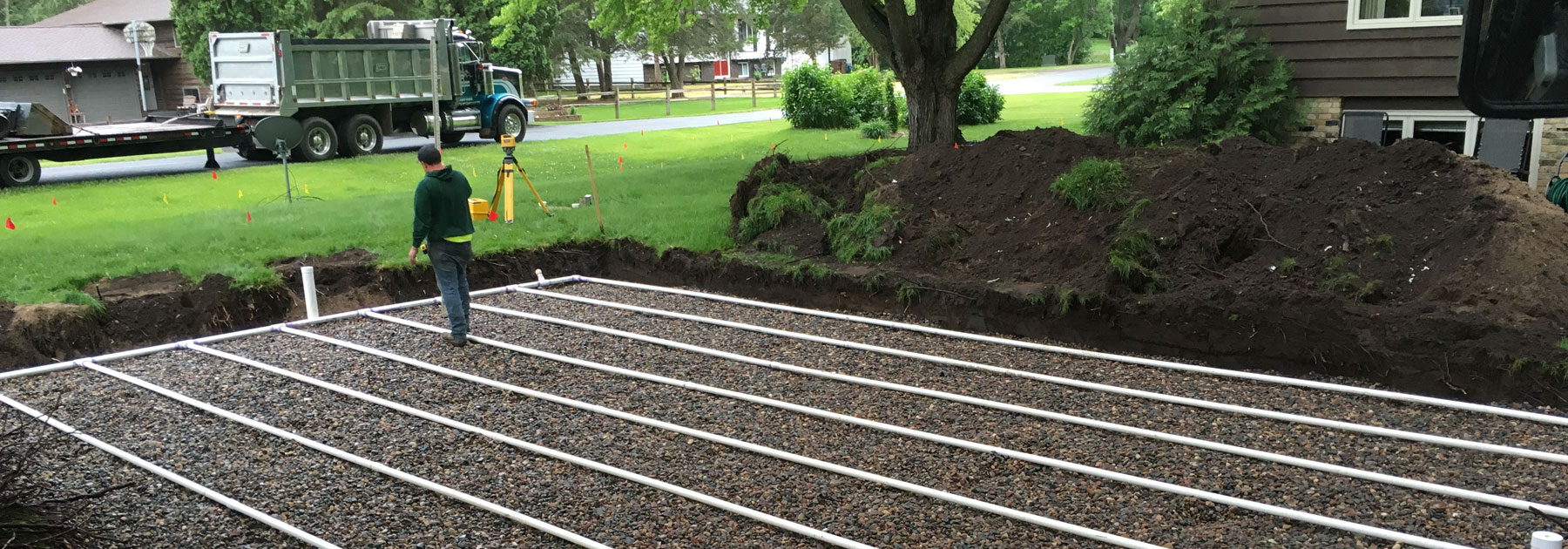
Pumping Your Septic Tank
May 31, 2022
Trenchless Excavation
July 29, 2022Steps for New Construction Site Preparation

Clearing the building site of trees and other debris is known as site preparation. To prepare for the installation of the foundation and footings, it also includes rough grading, staking the spot, and other activities. You must take into account factors that will affect or have an impact on where you will build your home before you start any site preparation.
These consist of:
• Geography (slopes)
• Easements and setbacks
• Driveway
• Views
• Sunlight exposure
• Trees
• Toilets and wells
• Additional homes in the area
• The separation between municipal services and utility lines
After giving these topics some thought, you should go through them once more before starting the site preparation. Remember, everything needs to be thoroughly examined because it’s simpler to make modifications before the concrete is poured.
Staking the Home
The home must be laid out during rough staking. Both aesthetic and financial considerations should drive this decision. Remember that clearing the building site is expensive (hourly wage). Therefore, it’s simpler to save time and money if you are aware of what needs to be done in advance. Remember that you don’t need to cut down any more trees than absolutely essential.
You can save the trees that don’t need to be cut down once you know where the house will be built. Does the site require any grading or excavation before the footings are put in place? So it becomes sense to rough stake the house to determine its precise location. It’s the most effective method for deciding which trees should be removed from the site and which should be left standing.
You can now make a few changes if you discover that the site has to have a few more trees removed that you might want to keep. Of course, you need to look for any setbacks and easements at the new location. Don’t forget to measure the distance between the new position and the septic tank’s drain field. Before moving to the new place, make sure you have the building rules department’s approval.
You can always conduct the rough staking yourself by measuring the property borders against the corners of the new house if you are confident enough to locate them. Of course, you need to employ a professional to manage the rough staking for you effortlessly if you are not adept at it or are concerned about the setbacks and easements.
Clearing
It entails clearing the construction site of any trees, roots, and other vegetation. Of course, you must have a suitable procedure for handling the waste leaving the site. While it is an alternative, having the trash hauled away is the most expensive.
On the other hand, you might need to bury the waste on the spot if you are cleaning up trash from a sizable rural property. Additionally, you might burn it and dispose of it properly. You must speak with your neighborhood fire department if you decide to burn it. If you decide to bury the debris, you must pick a spot that is far from where the house once stood.
Remember that as branches rot and the dirt becomes compacted over time, the trash hole begins to settle. As a result, there will be a surface depression, which with time will become unsightly, especially if it can be seen from where the home is. It can eventually result in drainage issues as well as damage to the decks, pathways, and drives. You might cut the logs if there are many of trees so you can use them in the fireplace in the winter.
Excavation
Will you think about constructing a basement for your house? Therefore, it must be dug up or excavated. Of course, at this point you have to deal with the surplus dirt problem. You can put the dirt there if there are any empty spaces on your land that need to be filled. To prevent incurring additional costs for moving the extra soil, you must be ready in advance.
A bulldozer can be used to excavate the basement space. As the excavation advances, the operator here makes a ramp to enter and exit the hole. To make sure the hole is dug to the proper depth, there needs to be someone who knows how to use a transit.
Basic Grading
You might have to shift some dirt if you want to reach the ideal grade level for your house. Don’t forget to take into account the drainage surrounding the house and the potential cost of moving the dirt. To put it simply, you must balance your cut and fill.
The ground that has been excavated is referred to as the cut, and the material that is added is referred to as fill. Find uses for the soil that has been removed from other parts of the land if at all possible to avoid paying a lot of money to have it hauled away.
Get the best possible grade by the deadline.
You must now ensure that a significant amount of grading has been completed. It will make moving around the construction site simpler. Even better, you can handle the finish grade without unpleasant shocks (when the building process of the home is completed.)
Some construction professionals like laying the slab and the driveway’s concrete at the same moment. Since it’s simpler to escape the mud, it makes it easier to construct the home. If this is the idea, the preliminary grading should tie down the elevations quite tightly.
When your home’s construction is complete and you are prepared to manage the outside issues, finish grading will be taken care of. Setting up for landscaping entails fine-tuning the drainage patterns surrounding the home. For site preparation needs, contact Bell Excavating/Bill Wolfe Excavating.
